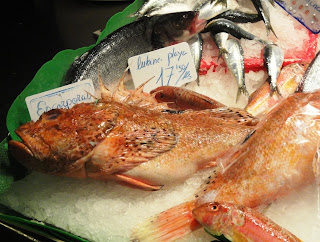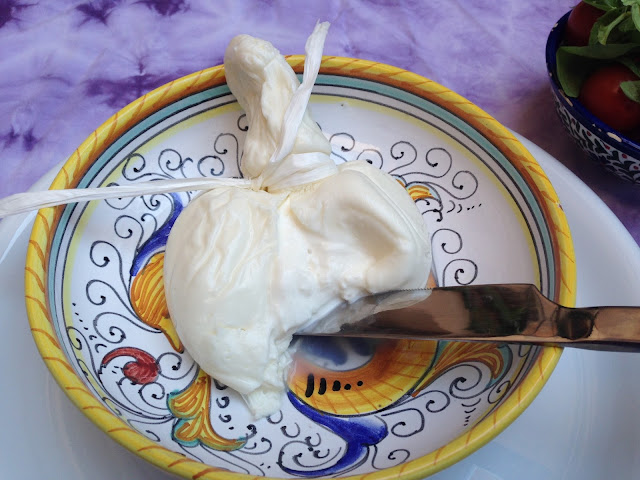The Boqueria market in Barcelona, Spain is a very special food market, and one of my absolute favorites in the world. And with good reason. The variety of colorful produce, unctuous Spanish hams and cheeses, fresh meats and poultry, and refreshing fruit shakes and ice popsicles are mind-blowing. The seafood section alone is worth the airfare to Spain! And like many central food markets in great European culinary capitals, the Boqueria offers several casual dining spots within the open-air walls of the market itself.
The Mercat de Sant Josep de la Boqueria -- the market's full name -- has been operating as such since 1840, but there has been a market in this general location since as early as 1217, when tables were installed in the area to sell meat. It operated as a pig market from 1470, and in a later incarnation became known as the Mercat della Palla (straw market) until 1794. Until the 19th century, the market was considered an extension of the market in Placa Nova, and was not enclosed. The market gained official status, and construction was begun in its current location, in 1840. It was designed by architect Mas Vilà and was inaugurated in 1853. You can ramble down Las Ramblas and walk into the main entrance here to the largest food market in Europe

There are plenty of tourists clogging the market's arteries, of course, but overlook the crowds and enjoy the scenery. This is where the locals shop, but even as a tourist you can purchase fresh fruit or veggies to snack on. The prices are more expensive than some smaller neighborhood markets but it's hard not to buy something, getting swept up in the atmosphere of the place.
I'll continue with mostly photos, since they offer the real feast for the eyes...
Gorgeous tropical fruit

and fruit juices.
Vibrant tomatoes, or tomate in Spanish...
...and jamon iberico de bellota...at 159 euros a kilo, or about $100 a pound. Yes. But it's really, really exquisite ham...
Cured anchovies, anchovies in vinegar (boquerones, one of the Mediterranean's greatest culinary inventions), and brandade, a dish of salt cod whipped with potatoes and garlic...
...as well as other cured fish products, like bottarga (cured sacks of mullet and tuna roe -- very expensive, and can be likened to a kind of "caviar prosciutto")...
...and salt cod. This is stock(fish) in trade in the Mediterranean. It's the single most popular fish on the Iberian peninsula, even though it's not a local fish. It's a testament to the permanence and importance of salt cod since the days of the Spanish and Portuguese explorers in the 15th and 16th centuries.
 Which brings us to the seafood part of the Boqueria market. Ahh, the seafood. It's spectacular. There really is no other way to describe such a bounty. If you like fish, crustaceans, or cephalopods (especially cephalopods!), like I do, you'll be in heaven here. This market makes me want to open a restaurant in Barcelona just so I can patronize this market. There are the usual suspects in Mediterranean fish (branzino, gilthead bream, turbot, etc.), sure. But there are cuttlefish and calamari, razor clams and octopus, too.
Which brings us to the seafood part of the Boqueria market. Ahh, the seafood. It's spectacular. There really is no other way to describe such a bounty. If you like fish, crustaceans, or cephalopods (especially cephalopods!), like I do, you'll be in heaven here. This market makes me want to open a restaurant in Barcelona just so I can patronize this market. There are the usual suspects in Mediterranean fish (branzino, gilthead bream, turbot, etc.), sure. But there are cuttlefish and calamari, razor clams and octopus, too.
There are chipirones, the teeny-tiny baby squid the size of a thumbnail, which are sweet and delicious, and used in all sorts of preparations in Catalonia.
There are lobsters and crabs and navajas (razor clams, those long, thin stacks of clams to the left of the photo), as well as the ever-popular sea cucumber, or cohombro, which has a texture not unlike squid.
There's the scorpion fish, which looks mean but its meat is sweet and often used in fish stews.
There are shrimp and clams galore, in all sizes and colors, perfect for paellas, fideus, and all kinds of soups, stews, tapas, and seafood dishes one can imagine.
And if we look closely, we see baby clams, snails, and even some of the gorgeous red shrimp I spoke about a few posts back. All of the seafood you see here is uncooked, and these are their colors in nature. Truly amazing.
And of course, we can't forget the female fish butchers, doing their job day in and day out with aplomb...and a very large knife!
No market shot would be complete without a little gore...
...like sheep heads and trotters and tripe (oh my!)
And of course, we can't forget the gentleman selling all those hot peppers.
Don't forget to stop by for lunch some time -- the offerings on hand are delicious, authentic, and prepared right before your eyes.
And grab a popsicle for a sweet ending to your market stroll! I hope you've enjoyed this virtual market jaunt as much as I enjoyed taking these photographs (and tasting the food). I'll explore more of Barcelona's food culture soon, in the ESCAPES section of my blog. Adios!
La Rambla 89, Raval neighborhood. www.boqueria.info. Open 8 am-8:30 p.m., Mon-Sat.
The Mercat de Sant Josep de la Boqueria -- the market's full name -- has been operating as such since 1840, but there has been a market in this general location since as early as 1217, when tables were installed in the area to sell meat. It operated as a pig market from 1470, and in a later incarnation became known as the Mercat della Palla (straw market) until 1794. Until the 19th century, the market was considered an extension of the market in Placa Nova, and was not enclosed. The market gained official status, and construction was begun in its current location, in 1840. It was designed by architect Mas Vilà and was inaugurated in 1853. You can ramble down Las Ramblas and walk into the main entrance here to the largest food market in Europe

There are plenty of tourists clogging the market's arteries, of course, but overlook the crowds and enjoy the scenery. This is where the locals shop, but even as a tourist you can purchase fresh fruit or veggies to snack on. The prices are more expensive than some smaller neighborhood markets but it's hard not to buy something, getting swept up in the atmosphere of the place.
I'll continue with mostly photos, since they offer the real feast for the eyes...
Gorgeous tropical fruit

and fruit juices.
Vibrant tomatoes, or tomate in Spanish...
...and jamon iberico de bellota...at 159 euros a kilo, or about $100 a pound. Yes. But it's really, really exquisite ham...
Cured anchovies, anchovies in vinegar (boquerones, one of the Mediterranean's greatest culinary inventions), and brandade, a dish of salt cod whipped with potatoes and garlic...
...as well as other cured fish products, like bottarga (cured sacks of mullet and tuna roe -- very expensive, and can be likened to a kind of "caviar prosciutto")...
...and salt cod. This is stock(fish) in trade in the Mediterranean. It's the single most popular fish on the Iberian peninsula, even though it's not a local fish. It's a testament to the permanence and importance of salt cod since the days of the Spanish and Portuguese explorers in the 15th and 16th centuries.
 Which brings us to the seafood part of the Boqueria market. Ahh, the seafood. It's spectacular. There really is no other way to describe such a bounty. If you like fish, crustaceans, or cephalopods (especially cephalopods!), like I do, you'll be in heaven here. This market makes me want to open a restaurant in Barcelona just so I can patronize this market. There are the usual suspects in Mediterranean fish (branzino, gilthead bream, turbot, etc.), sure. But there are cuttlefish and calamari, razor clams and octopus, too.
Which brings us to the seafood part of the Boqueria market. Ahh, the seafood. It's spectacular. There really is no other way to describe such a bounty. If you like fish, crustaceans, or cephalopods (especially cephalopods!), like I do, you'll be in heaven here. This market makes me want to open a restaurant in Barcelona just so I can patronize this market. There are the usual suspects in Mediterranean fish (branzino, gilthead bream, turbot, etc.), sure. But there are cuttlefish and calamari, razor clams and octopus, too.There are chipirones, the teeny-tiny baby squid the size of a thumbnail, which are sweet and delicious, and used in all sorts of preparations in Catalonia.
There are lobsters and crabs and navajas (razor clams, those long, thin stacks of clams to the left of the photo), as well as the ever-popular sea cucumber, or cohombro, which has a texture not unlike squid.
There's the scorpion fish, which looks mean but its meat is sweet and often used in fish stews.
There are shrimp and clams galore, in all sizes and colors, perfect for paellas, fideus, and all kinds of soups, stews, tapas, and seafood dishes one can imagine.
And if we look closely, we see baby clams, snails, and even some of the gorgeous red shrimp I spoke about a few posts back. All of the seafood you see here is uncooked, and these are their colors in nature. Truly amazing.
And of course, we can't forget the female fish butchers, doing their job day in and day out with aplomb...and a very large knife!
No market shot would be complete without a little gore...
...like sheep heads and trotters and tripe (oh my!)
And of course, we can't forget the gentleman selling all those hot peppers.
Don't forget to stop by for lunch some time -- the offerings on hand are delicious, authentic, and prepared right before your eyes.
And grab a popsicle for a sweet ending to your market stroll! I hope you've enjoyed this virtual market jaunt as much as I enjoyed taking these photographs (and tasting the food). I'll explore more of Barcelona's food culture soon, in the ESCAPES section of my blog. Adios!
La Rambla 89, Raval neighborhood. www.boqueria.info. Open 8 am-8:30 p.m., Mon-Sat.























